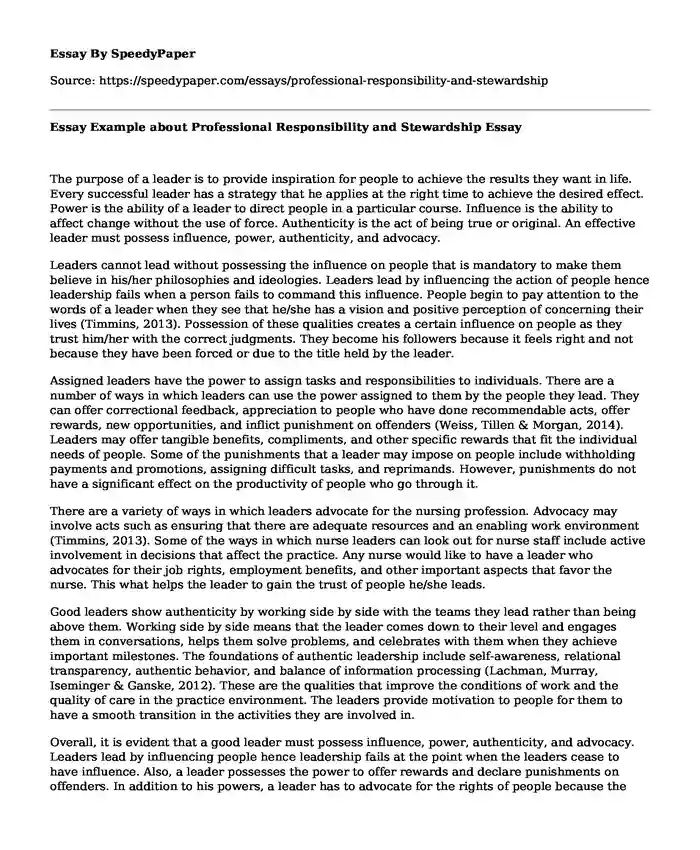
| Type of paper: | Essay |
| Categories: | Nursing leadership |
| Pages: | 3 |
| Wordcount: | 702 words |
The purpose of a leader is to provide inspiration for people to achieve the results they want in life. Every successful leader has a strategy that he applies at the right time to achieve the desired effect. Power is the ability of a leader to direct people in a particular course. Influence is the ability to affect change without the use of force. Authenticity is the act of being true or original. An effective leader must possess influence, power, authenticity, and advocacy.
Leaders cannot lead without possessing the influence on people that is mandatory to make them believe in his/her philosophies and ideologies. Leaders lead by influencing the action of people hence leadership fails when a person fails to command this influence. People begin to pay attention to the words of a leader when they see that he/she has a vision and positive perception of concerning their lives (Timmins, 2013). Possession of these qualities creates a certain influence on people as they trust him/her with the correct judgments. They become his followers because it feels right and not because they have been forced or due to the title held by the leader.
Assigned leaders have the power to assign tasks and responsibilities to individuals. There are a number of ways in which leaders can use the power assigned to them by the people they lead. They can offer correctional feedback, appreciation to people who have done recommendable acts, offer rewards, new opportunities, and inflict punishment on offenders (Weiss, Tillen & Morgan, 2014). Leaders may offer tangible benefits, compliments, and other specific rewards that fit the individual needs of people. Some of the punishments that a leader may impose on people include withholding payments and promotions, assigning difficult tasks, and reprimands. However, punishments do not have a significant effect on the productivity of people who go through it.
There are a variety of ways in which leaders advocate for the nursing profession. Advocacy may involve acts such as ensuring that there are adequate resources and an enabling work environment (Timmins, 2013). Some of the ways in which nurse leaders can look out for nurse staff include active involvement in decisions that affect the practice. Any nurse would like to have a leader who advocates for their job rights, employment benefits, and other important aspects that favor the nurse. This what helps the leader to gain the trust of people he/she leads.
Good leaders show authenticity by working side by side with the teams they lead rather than being above them. Working side by side means that the leader comes down to their level and engages them in conversations, helps them solve problems, and celebrates with them when they achieve important milestones. The foundations of authentic leadership include self-awareness, relational transparency, authentic behavior, and balance of information processing (Lachman, Murray, Iseminger & Ganske, 2012). These are the qualities that improve the conditions of work and the quality of care in the practice environment. The leaders provide motivation to people for them to have a smooth transition in the activities they are involved in.
Overall, it is evident that a good leader must possess influence, power, authenticity, and advocacy. Leaders lead by influencing people hence leadership fails at the point when the leaders cease to have influence. Also, a leader possesses the power to offer rewards and declare punishments on offenders. In addition to his powers, a leader has to advocate for the rights of people because the power originates from the people. Lastly, a good leader must show authenticity by working side by side with people rather than above them. The present and future generations of leaders should have in mind the needs of people when making important decision.
References
Lachman, V. D., Murray, J. S., Iseminger, K., & Ganske, K. M. (2012). Doing the right thing: pathways to moral courage. American Nurse Today, 7(5), 24-29. Retrieved from https://www.americannursetoday.com/doing-the-right-thing-pathways-to-moral-courage/
Timmins, F. (2013). Professionalism and Self-Presentation. Professional Behaviour in Healthcare Professions: Professionalism and Self-Presentation. Nurse Education in Practice, 13(3), e8. Retrieved from https://www.sciencedirect.com/science/article/pii/S1471595312002338
Weiss, D., Tillen, F. J., & Morgan, M. J. (2014). The interprofessional healthcare team: Leadership and development. Burlington, MA: Jones & Bartlett Learning. ISBN-13: 9781449673369
Cite this page
Essay Example about Professional Responsibility and Stewardship. (2022, Sep 09). Retrieved from https://speedypaper.net/essays/professional-responsibility-and-stewardship
Request Removal
If you are the original author of this essay and no longer wish to have it published on the SpeedyPaper website, please click below to request its removal:
- International Business Essay Example
- Free Essay on Family System Theory and Family Interventions
- Free Essay on the Opera Monteverdi Tu se morta from Orfeo and Purcell Didos lament
- Paper Sample Comprising a Psychology Learning Project Report
- Free Essay with Q&A on Water Pollution
- The Woman in White - Free Essay on Close Reading of a Chapter
- Essay Sample: NextEra Energy Company
Popular categories




